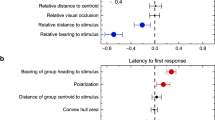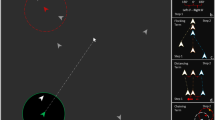Abstract
Access to information is a key advantage of grouping. Although experienced animals can lead others to solve problems, less is known about whether partially informed individuals can pool experiences to overcome challenges collectively. Here we provide evidence of such ‘experience-pooling’. We presented shoals of sticklebacks (Gasterosteus aculeatus) with a two-stage foraging task requiring them to find and access hidden food. Individual fish were either inexperienced or had knowledge of just one of the stages. Shoals containing individuals trained in each of the stages pooled their expertise, allowing more fish to access the food, and to do so more rapidly, compared with other shoal compositions. Strong social effects were identified: the presence of experienced individuals increased the likelihood of untrained fish completing each stage. These findings demonstrate that animal groups can integrate individual experience to solve multi-stage problems, and have implications for our understanding of social foraging, migration and social systems.
This is a preview of subscription content, access via your institution
Access options
Access Nature and 54 other Nature Portfolio journals
Get Nature+, our best-value online-access subscription
$29.99 / 30 days
cancel any time
Subscribe to this journal
Receive 12 digital issues and online access to articles
$119.00 per year
only $9.92 per issue
Buy this article
- Purchase on Springer Link
- Instant access to full article PDF
Prices may be subject to local taxes which are calculated during checkout


Similar content being viewed by others
References
Krause, J. & Ruxton, G. D. Living in Groups (Oxford Univ. Press, 2002).
Danchin, É. et al. Public information: from nosy neighbors to cultural evolution. Science 305, 487–491 (2004).
Couzin, I. D. et al. Effective leadership and decision-making in animal groups on the move. Nature 433, 513–516 (2005).
Couzin, I. D. Collective cognition in animal groups. Trends Cogn. Sci. 13, 36–43 (2009).
Krause, J., Ruxton, G. D. & Krause, S. Swarm intelligence in animals and humans. Trends Ecol. Evol. 25, 28–34 (2010).
Sumpter, D. J. Collective Animal Behavior (Princeton Univ. Press, 2010).
Laland, K. N., Atton, N. & Webster, M. M. From fish to fashion: experimental and theoretical insights into the evolution of culture. Phil. Trans. R. Soc. Lond. B 366, 958–968 (2011).
Ward, A. J. et al. Fast and accurate decisions through collective vigilance in fish shoals. Proc. Natl Acad. Sci. USA 108, 2312–2315 (2011).
Berdahl, A. et al. Emergent sensing of complex environments by mobile animal groups. Science 339, 574–576 (2013).
Ioannou, C. C. Swarm intelligence in fish? The difficulty in demonstrating distributed and self-organised collective intelligence in (some) animal groups. Behav. Process. http://dx.doi.org/10.1016/j.beproc.2016.10.005 (2016).
Ward, A. J. W. & Webster, M. M. Sociality: The Behaviour of Group Living Animals (Springer, 2016).
Bonabeau, E., Dorigo, M. & Theraulaz, G. Swarm Intelligence: From Natural to Artificial Systems (Oxford Univ. Press, 1999).
Garnier, S., Gautrais, J. & Theraulaz, G. The biological principles of swarm intelligence. Swarm Intel. 1, 3–31 (2007).
Codling, E. A., Pitchford, J. W. & Simpson, S. D. Group navigation and the ‘many-wrongs principle’ in models of animal movement. Ecology 88, 1864–1870 (2007).
Codling, E. A. & Bode, N. W. Balancing direct and indirect sources of navigational information in a leaderless model of collective animal movement. J. Theor. Biol. 394, 32–42 (2016).
Morand-Ferron, J. & Quinn, J. L. Larger groups of passerines are more efficient problem solvers in the wild. Proc. Natl Acad. Sci. USA 108, 15898–15903 (2011).
Dyer, J. R. et al. Leadership, consensus decision making and collective behaviour in humans. Phil. Trans. R. Soc. Lond. B 364, 781–789 (2009).
Ioannou, C. C., Singh, M. & Couzin, I. D. Potential leaders trade off goal-oriented and socially oriented behavior in mobile animal groups. Am. Nat. 186, 284–293 (2015).
Jolles, J. W. et al. The role of social attraction and its link with boldness in the collective movements of three-spined sticklebacks. Anim. Behav. 99, 147–153 (2015).
Webster, M. M. Experience and motivation shape leader–follower interactions in fish shoals. Behav. Ecol. 28, 77–84 (2017).
Conradt, L. et al. ‘Leading according to need’ in self-organizing groups. Am. Nat. 173, 304–312 (2009).
Day, R. L. et al. Interactions between shoal size and conformity in guppy social foraging. Anim. Behav. 62, 917–925 (2001).
Atton, N. et al. Information flow through threespine stickleback networks without social transmission. Proc. R. Soc. Lond. B 279, 4272–4278 (2012).
Krause, S. et al. Swarm intelligence in humans: diversity can trump ability. Anim. Behav. 81, 941–948 (2011).
Reader, S. M. & Laland, K. N. Diffusion of foraging innovations in the guppy. Anim. Behav. 60, 175–180 (2000).
Atton, N. et al. Familiarity affects social network structure and discovery of prey patch locations in foraging stickleback shoals. Proc. R. Soc. Lond. B 281, 20140579 (2014).
Webster, M. M. & Laland, K. N. Evaluation of a non-invasive tagging system for laboratory studies using three-spined sticklebacks (Gasterosteus aculeatus). J. Fish Biol. 75, 1868–1873 (2009).
R Core Team R: A Language and Environment for Statistical Computing (R Foundation for Statistical Computing, 2013).
Therneau, T. M. & Lumley, T. survival: Survival analysis v. 2.41-2. https://cran.r-project.org/web/packages/survival/index.html (2015).
Acknowledgements
This work was funded by an ERC Advanced Grant to K.N.L. (EVOCULTURE, ref. 232823). We thank K. Meacham for assistance in preparing the manuscript.
Author information
Authors and Affiliations
Contributions
M.M.W. designed and performed the experiments. M.M.W., A.W. and K.N.L. analysed the data and co-authored the paper.
Corresponding author
Ethics declarations
Competing interests
The authors declare no competing financial interests.
Supplementary information
Supplementary Information
Supplementary Methods; Supplementary Figures 1–4; Supplementary Tables 1–3 (PDF 308 kb)
Rights and permissions
About this article
Cite this article
Webster, M., Whalen, A. & Laland, K. Fish pool their experience to solve problems collectively. Nat Ecol Evol 1, 0135 (2017). https://doi.org/10.1038/s41559-017-0135
Received:
Accepted:
Published:
DOI: https://doi.org/10.1038/s41559-017-0135
This article is cited by
-
Aggregating behaviour in invasive Caribbean lionfish is driven by habitat complexity
Scientific Reports (2019)
-
Individual- and population-level drivers of consistent foraging success across environments
Nature Ecology & Evolution (2018)



